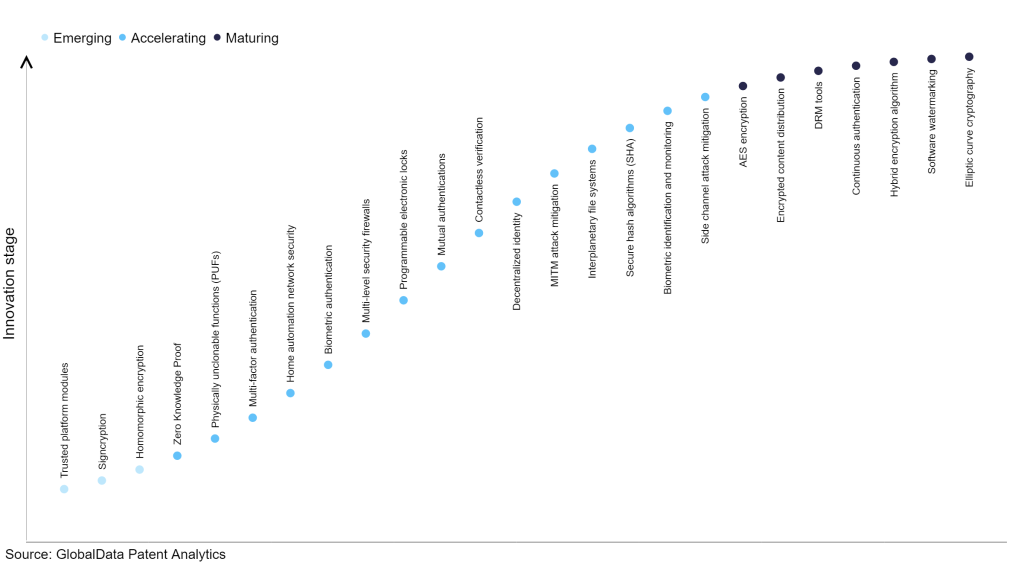The technology industry continues to be a hotbed of patent innovation. Activity is driven by the increasing value of software assets, the need to prevent piracy and unauthorized copying, and the rising concerns regarding intellectual property theft, as well as growing importance of technologies such as digital watermarking, code obfuscation, steganography, and cryptographic algorithms. These technologies allow developers to embed unique and imperceptible marks or signatures within the software code, enabling the identification of the rightful owner and tracing unauthorized usage. In the last three years alone, there have been over 4.1 million patents filed and granted in the technology industry, according to GlobalData’s report on Cybersecurity in technology: software watermarking. Buy the report here.
However, not all innovations are equal and nor do they follow a constant upward trend. Instead, their evolution takes the form of an S-shaped curve that reflects their typical lifecycle from early emergence to accelerating adoption, before finally stabilizing and reaching maturity.
Identifying where a particular innovation is on this journey, especially those that are in the emerging and accelerating stages, is essential for understanding their current level of adoption and the likely future trajectory and impact they will have.
190+ innovations will shape the technology industry
According to GlobalData’s Technology Foresights, which plots the S-curve for the technology industry using innovation intensity models built on over 1.5 million patents, there are 190+ innovation areas that will shape the future of the industry.
Within the emerging innovation stage, trusted platform modules, signcryption, and homomorphic encryption, are disruptive technologies that are in the early stages of application and should be tracked closely. Zero knowledge proof, physically unclonable functions (PUFs), and multi-factor authentication are some of the accelerating innovation areas, where adoption has been steadily increasing. Among maturing innovation areas are AES encryption and encrypted content distribution, which are now well established in the industry.
Innovation S-curve for cybersecurity in the technology industry

Software watermarking is a key innovation area in cybersecurity
Software watermarking involves the incorporation of digital information into a software program to enable its tracking and identification, serving purposes such as safeguarding intellectual property and detecting instances of piracy. By embedding unique digital identifiers or marks within the software, it becomes possible to trace and identify unauthorized use or distribution. Software watermarking is an effective technique used to protect the ownership and integrity of software assets, deterring piracy, and ensuring the rightful usage of intellectual property.
GlobalData’s analysis also uncovers the companies at the forefront of each innovation area and assesses the potential reach and impact of their patenting activity across different applications and geographies. According to GlobalData, there are 180+ companies, spanning technology vendors, established technology companies, and up-and-coming start-ups engaged in the development and application of software watermarking.
Key players in software watermarking – a disruptive innovation in the technology industry
‘Application diversity’ measures the number of applications identified for each patent. It broadly splits companies into either ‘niche’ or ‘diversified’ innovators.
‘Geographic reach’ refers to the number of countries each patent is registered in. It reflects the breadth of geographic application intended, ranging from ‘global’ to ‘local’.
Patent volumes related to software watermarking
Source: GlobalData Patent Analytics
Sony Group is the leading patent filer in software watermarking. The company’s patents are aimed at a non-transitory computer-readable storage medium provided for storing computer program instructions that cause a computer to implement a method of exchanging content.
The method includes connecting to an information processing apparatus and transferring an ID of the computer to the information processing apparatus when a connection to the information processing apparatus is detected. The method further includes storing content and data related to the content transmitted from the information processing apparatus, transferring the data corresponding to the content stored in the computer, and reproducing the stored content. The content is automatically transferred to the computer when the computer is judged to be a predetermined device.
Other prominent patent filers in the space include Microsoft and Intel.
By geographic reach, Digital Media Technology leads the pack, followed by Vaporstream and Dropbox. In terms of application diversity, Digimarc holds the top position, followed by Digital Media Technology and AT&T.
Cybersecurity innovation in software watermarking focuses on protecting software intellectual property and detecting unauthorized use or distribution. By implementing software watermarking techniques, organizations can enhance the protection of their valuable software assets, deter piracy, and maintain control over their intellectual property rights.
To further understand how cybersecurity is disrupting the technology industry, access GlobalData’s latest thematic research report on Cybersecurity.
Premium Insights
From

The gold standard of business intelligence.
Blending expert knowledge with cutting-edge technology, GlobalData’s unrivalled proprietary data will enable you to decode what’s happening in your market. You can make better informed decisions and gain a future-proof advantage over your competitors.





